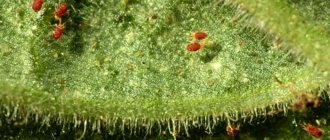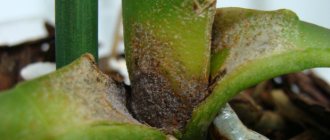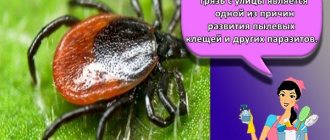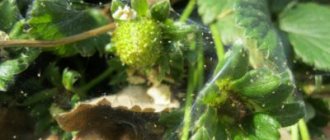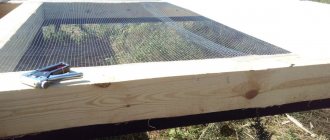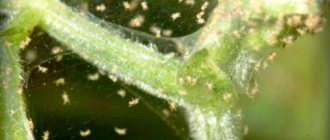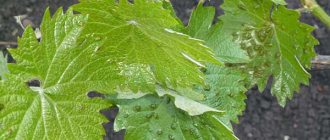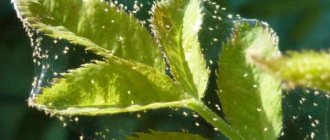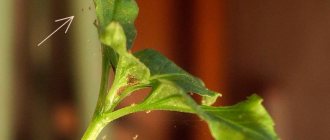Why are spider mites dangerous?
The mite sucks out cell sap from the plant using its mouth organ, which resembles a syringe and works on the same principle. In order to get food, the mite has to put in a lot of effort, but this still doesn’t make it any easier for the plant.
Due to their nature, unfertilized female spider mites can lay unfertilized eggs, from which the same females then hatch (this phenomenon is called parthenogenesis). This property allows pests to reproduce even faster.
Females attach eggs to the surface of leaves during plant growth. If you look closely, in the cracks and cracks of the greenhouse you can find females who have settled there for the winter, as well as eggs laid.
Preparing the greenhouse for pest control
In order to have a good effect from the treatment against ticks, you need to carry out the correct preparatory work:
- remove all plant debris from the greenhouse immediately;
- remove all equipment and watering containers from the greenhouse;
- remove the top layer of soil by 5-7 cm;
- wash the greenhouse with warm water;
- wash all surfaces and frame with a solution of laundry soap or potassium permanganate;
- After the greenhouse has dried, coat the wooden frame with slaked lime, and the metal frame with kerosene.
Conditions for the reproduction and development of spider mites
Air temperature affects how quickly spider mites develop. In open ground, most species of mites can produce 1-2 generations per year, while more dangerous mites (spider and hawthorn mites) are capable of reproducing 4-5 generations annually. This is not surprising, because spider mites feel great already at 12°C. If such a pest enters a heated greenhouse in winter, it can reproduce continuously and produce up to 22 generations per year.
One female spider mite is quite capable of laying from 10 to 150 eggs under optimal conditions. The warmer it gets outside, the faster ticks multiply. As a result, generations mix, and eggs, larvae, and adult mites can be present in one colony. At this rate, spider mites in 2-3 generations can easily destroy the entire crop that is grown in a greenhouse.
In addition to the fact that spider mites eat in quantity, they also prefer a pasture type of feeding: they pierce cells and drink juice every few minutes. As a result, the cells are very quickly destroyed and the plant dies.
How to treat a greenhouse
At different times of the year, prevention and control costs are a little different. Let's look at how exactly.
in autumn
Check out
How and with what to treat a greenhouse in the fall and prepare it for winter If mites have infested the greenhouse by the end of summer, then after harvesting the covering should be replaced, completely getting rid of the old one.
If it is difficult to do this directly, you should cover everything with snow.
Afterwards, you should organize a general cleaning: wash the entire structure completely, disinfect it with a solution of acaricidal agents or copper sulfate (5%), and a solution of bleach (5%).
To prepare the latter, you need to dilute a full bucket of water with 500 g of the substance. The film that covers the winter garden should be left until spring. In autumn it is also worth using sulfur bombs.
in spring
It makes sense to treat at this time if your or a neighboring plot has been damaged earlier, since in this case there is a high probability that the pests will hide en masse to spend the winter, and in the spring they will definitely begin active life. However, if they have been avoiding your area, spring treatment may be unnecessary.
Sometimes irrigation alone is not enough: it will not lead to the desired result, because the soil and walls of the greenhouse remain contaminated. You need to start processing in the spring from the soil, because the insect overwinters directly there. The film should be removed just in the spring and then destroyed. Then you need abundant watering. If infected parts are found, they should be torn off and burned.
Quite effective means of combating parasites are watering with acaricidal solutions or burying special sticks, which dissolve after watering, enter the root system and distribute pesticides inside the plant.
We recommend that you read: treatment of polycarbonate greenhouses against diseases and pests in the spring.
How to detect spider mites
Thanks to their webs, pests can quickly move throughout the plant
Finding spider mites is not difficult - these arachnids like to climb under leaves between the veins, they love buds and young shoots. Thanks to their webs, pests can quickly move throughout the plant, and also fly to plants that grow nearby.
The most important sign of a tick is a spider web with black moving dots. Dots also appear on the leaves - puncture marks. After some time, such a leaf begins to dry out, changes color from green to brown, curls and falls off.
The web, in addition to helping mites move freely around plants, also protects them from predators and the environment, and also helps maintain the optimal temperature for mites and maintains the required level of humidity.
Find and destroy
In the film, the title of which sounds the same as the title of this section, the main character struggled with the enemy for a long time.
For the final victory, he needed to draw up a clear military strategy. The summer resident should do the same. Without a strategy, the harvest will go entirely to the winner, the spider mite. If these arachnids spread unhindered, the plants die completely. First you need to find the enemy. And the sooner this is done, the faster the victory will be.
The first sign of a mite infestation is the appearance of yellow dots along the central vein of the leaf. Pests can settle on 190 species of cultivated and wild plants, for example, cucumbers, peppers, eggplants, pumpkins and melons, but they practically never appear on tomatoes. Moreover, greenhouses are attacked more often than open ground.
The appearance of yellow dots on the leaves is a sign of spider mites
After some time, the yellow spots on the leaves increase because the pest pierces the leaf cell and feeds on its juice. A cobweb appears on the back of the sheet, along which uninvited guests move. Then the leaves finally turn yellow and dry out. First, the mites destroy all the leaves, and then they move to the upper part of the plant and eat the fruits and young leaves.
A plant infected with spider mites
Spider mites - how to fight effectively
Killing spider mites is not that easy. Even treating plants every 14 days will not give the desired effect, because... The pest population is constantly increasing. In addition, many popular acaricides cannot affect tick eggs; after treatment, new individuals will hatch from them, and the pest population will quickly return to its original size.
Plants growing in a greenhouse should be treated with acaricides before the new generation of mites begins to reproduce (5-7 days after the previous treatment).
An important factor for tick reproduction is humidity at 30-50%. Typically, the above level is maintained with regular ventilation of the greenhouse. But mites slightly reduce their reproduction rate at 90% humidity. This means that in the fight there must be an integrated approach - the use of acaricides and increasing the importance to 80-90% and higher (however, we must remember that not all plants are suitable for such conditions).
Regular spraying with water will also help fight pests - after all, the mites themselves and their eggs die in its drops. True, if you see that some plants are severely affected, they need to be removed, because they will pose a danger to others - healthy plants.
In order to effectively fight spider mites in a greenhouse, you will have to change the plant feeding regime. Fertilizers containing nitrogen, which are actively used in greenhouses, are favorable for mite reproduction; during the fight, their use should be minimized. The pest does not like phosphorus, potassium and calcium - fertilizers with these microelements slow down the growth of its population. Therefore, in the fight against mites, it is recommended, in parallel with the use of acaricidal drugs, to feed the crops with potassium sulfate, monopotassium phosphate, calcium nitrate, etc.
During the period of pest control, gardeners do not recommend getting carried away with “organic” products, as well as preparations containing amino acids and phytohormones. After all, the main thing at this moment is to protect the plants from mites, and only then you can think about how to restore their decorative properties.
Ticks easily adapt to medications, so they need to be changed - one active ingredient can only be used once a season. To stop a mite outbreak, 3-4 treatments will be needed. Ideally, acaricidal treatments should be carried out once a week. The very first treatment for spider mites should begin with the use of the drug Antiklesch or Apollo. When processing, it is necessary to take into account the temperature regime - the effectiveness of the treatments, as well as their frequency, depends on this.
As a rule, after each treatment (usually after 12-24 hours) assess how effective it was. To do this, control plants are examined under a magnifying glass. If 2-3 days after the treatment you see a significant mass of moving mites, the treatment must be repeated, but in this case you will have to use a different drug (of a different brand and with a different active ingredient!). The most effective remedies for spider mites are Fitoverm and Biokill. The undeniable advantage of these drugs is that ticks adapt to them slowly.
When treating plants against spider mites, acaricides of different groups should not be mixed. Although this will increase the efficiency of treatment, there is a risk that next season ticks will appear on your site that will be resistant to several drugs at once, and it will be much more difficult to fight them.
Characteristics of the insect
Spider mites are harmful insects whose habitat is houseplants, garden crops, and especially greenhouse plants - due to the favorable temperature for them in greenhouses. It is difficult to fight ticks because they are very small. They cannot be noticed until the leaves become covered with cobwebs and the plants lose their usual appearance: they become lethargic and then dry out completely.
The web is so strong that when sprayed with a spray bottle it is difficult to break. In her cocoons, the female lays up to 400 eggs daily with a life expectancy of 40 to 50 days. This shows the avalanche-like speed at which the number of insects is increasing. In winter, the development process in greenhouses stops, and resumes with the beginning of the season.
The length of the female is from 0.4 to 0.6 mm, the male is even smaller. They have a pale green or amber-yellow color. The young offspring of ticks are six-legged, and after several molts they become eight-legged. The favorable environment for the growth of an individual is 25-30 degrees, and its development ends in 7-8 days. At lower temperatures, this process slows down and lasts up to a month.
The tick belongs to the class of arachnids. Usually it is located on the back side of the leaf, feeding on its juice and eating out many small holes. Dehydration causes leaves to become dry and brittle. Even with minor damage, plant development is suspended, and if measures are not taken to destroy parasites, crops lose their ability to recover, and the process of photosynthesis decreases. Diseased leaves become covered with a thin web, turn yellow and fall off.
The particular harm caused by mites lies in their ability to cause significant damage to plants in a short period of time. Hordes of microscopic parasites attack plants, which become sick and then die. This distinguishes them from other plant pests. Therefore, we have to destroy them using various means.
Natural enemies of spider mites
Good news: spider mites have natural enemies! This fact can be used in pest control. The enemies of spider mites are predatory mites - phytoseiids. These moving arthropods love to feast on spider mites and can eat about a hundred harmful individuals per day.
To combat spider mites, phytoseiids are bred artificially and released into a greenhouse. After hordes of beneficial arthropods have settled in the greenhouse, you can reduce the treatment of plants with acaricides. However, even rare treatments can destroy helpers - phytoseiids are very sensitive to acaricides. Therefore, experts recommend re-releasing phytoseiids after the effect of the acaricide has ended.
In order for measures to combat spider mites to be effective, along with spraying, it is necessary to maintain a high level of humidity in the greenhouse, as well as increase the immunity of plants with the help of correct and timely fertilizing, which helps strengthen the cell walls. You can defeat spider mites only if you use all control methods in combination.
Folk remedies
If agrotechnical methods of exterminating insects prevent their appearance, then folk methods can be used when the mite has already occupied the greenhouse and poses a threat to the future harvest. If fruits have appeared on the plants or they are to be harvested soon, there is no need to use chemicals. It is better to use old, reliable means that do not harm plants and fruits, but have a detrimental effect on parasites. You can use the following methods:
- Prepare an infusion of potato tops and water the beds with it. After 2-3 hours, the mites will die, but the eggs will remain unharmed. Therefore, it is necessary to additionally process 3-4 times.
- Irrigate with the same decoction with the addition of a solution of laundry soap. After this procedure, not only arachnids die, but also aphids and other pests.
- Watering with an infusion of onion peels will help get rid of parasites.
- Herbs are also used: datura vulgare, alder, wormwood carpesium, garlic extract.
To repel and also kill insects, you can spray the plants with vinegar, hydrogen peroxide or ammonia. The method used is to wash the leaves with an infusion of horseradish, yarrow, garlic and the most common anti-mite remedy - a solution of tar or laundry soap.
If the infestation of the beds is minor, you can cover them with polyethylene for a short time to retain moisture longer, which has a detrimental effect on most individuals. However, treating a greenhouse against spider mites with folk remedies can destroy only some of its species, and with the simultaneous use of chemicals, the result will be more effective.
Signs of a parasite
Most often, the pest enters the greenhouse with young seedlings or through the gardener’s clothing. Less commonly, animals carry it onto plants. At the initial stages of colonization, it is very difficult to notice the presence of a tick. White spots may appear on the leaves, which can easily be confused with some third-party problem, for example, lack of moisture.
After a few days, the markers will begin to turn yellow (especially noticeable on the tomato), and after a week, when the parasites have multiplied, it will be possible to examine each individual individual. Later, a specific web will appear, indicating the development of the colony. Those plants that are located closest to the passages and exits of the greenhouse are most at risk. This suggests that the infection came from the street.
Read more ► Do ticks fly or not, why are they confused with moose flies?
Spider mites suck out plant juices, thereby disturbing the water balance: the leaves are depleted and the stem dries out. But the pest is dangerous only for flora. The parasite cannot cause any significant harm to human health (infect or bite).
Chemical methods of controlling spider mites
If you have used the above means, but are not satisfied with the result, then it is time to use heavy artillery. It is almost impossible to eliminate a large lesion without chemical methods. The industry has developed special preparations against ticks, they are called acaricides.
There are many chemicals against spider mites, but they cannot be used during fruit formation
Attention! After chemical treatment of fruit-bearing crops, vegetables can be eaten only after 3 to 5 days, depending on the product.
- To spray vegetables, you can use colloidal sulfur (80 g per 10 liters of water) or ground sulfur 4 g/m3.
- Fitoverm (10 ml per 10 liters of water) is also suitable.
- If you use bitoxibacillin, then you need to dilute 100 g. for 10 l. water.
- BI-58 (10-15 ml per 10 liters of water) can help in the fight. Even if it was not possible to spray the infected leaves completely, the mites still die, since the drug moves along with the plant sap.
- Vermitek, Actofit, Apollo, Flumite, Fitoferm, Actellik and other mixtures. But if you see that after 3-4 times the drug does not work properly, it means that the arachnids have adapted.
- The drug Plant-Plin is suitable for combating uninvited guests. It comes in the form of sticks that need to be instilled in the root zone. When watering, the substance gradually dissolves and acts on pests after 2-3 days.
- Etisso is used in the same way.
- Acteplik is one of the most serious remedies. One ampoule of the product (5 ml) is diluted with a liter of water. It is better to treat plants using a spray bottle.
All of the above products can be used every 10-15 days. In case of extensive infection - after 5-10 days.
Your strategy will be victorious if you do not give up and are not afraid to apply the means comprehensively. And if necessary, then in high concentration.
Types of mites on houseplants
Among plant diseases, spider mites occupy a special place. Phytophages are persistent and difficult to remove pests, including several species:
- The common spider mite is a species common on the ground and indoors. Colonies settle on the underside of leaves, hiding from the sun's rays. Adults quickly crawl from the infected plant to neighboring flowers.
- Red mite - indoor plants often suffer from attacks by a small pest that settles on lemon, orchids, roses, and balsam. Soft-bodied females measuring 0.5 mm are purple, males 0.3 mm are bright red.
- False spider mite - has a miniature size of 0.25 mm; it does not spin webs. Infection becomes noticeable when there are a huge number of individuals.
- The Atlantic mite is similar in appearance to the spider mite. Propagates in any humidity, prefers palms and citrus trees.
- Cyclamen mite - affects the edges of leaves, buds and stems. Not noticeable to the naked eye. Colonies settle on the upper side of the leaves and look like a layer of dust. Pests choose cyclamens, balsams, chrysanthemums and other tuberous plants.
- The broad spider mite is a very prolific phytophage; a new generation appears on the leaves every 5 days. After 2-3 weeks, the plant becomes entangled in cobwebs and clusters of mites that look like reddish-brown dust. The pest attacks oleander, ficus, cactus, tagetis. Sulfur preparations are effective in combating it.
- Cactus flat mite - it is recommended to use insecticides to destroy phytophages. Carry out the treatment several times with an interval of 7 days.
Prevention
Prevention of spider mites includes the following measures:
- Constant timely cleaning of weeds with their subsequent disposal.
- Alternating different types of plants in one place. After the vegetables that the tick simply adores, you should plant those that the tick cannot stand.
- Always apply possible agricultural measures to any plants to create conditions unsuitable for ticks. It is especially important to maintain constant high humidity by spraying or watering the crops from above.
- Regularly inspect plants in order to promptly detect traces of the presence of small pests - cobwebs and colorless dry spots on leaves and shoots.
How do indoor plants become infected?
The pest enters plants in various ways:
- With an infected indoor flower. When purchasing a new plant, you should carefully examine its leaves. You won’t be able to spot a tick, but yellow dots on the leaves will make you think about the health of the plant.
Advice. It is recommended to quarantine a new flower for 2 weeks. If it turns out that it is a carrier of the pest, only it will have to be treated, and the rest of the plants will not be harmed.
- With soil. Store-bought or street soil may be fraught with danger in the form of females or spider mite larvae. Arachnids can enter diapause, a state of slow metabolism, under unfavorable conditions. They come to life as the temperature increases and the humidity decreases. After the start of the heating season, the pest begins active life.
Advice. It is recommended to bake soil taken from the street in the oven.
- Through an open window with the wind. Residents of the first floors risk their indoor plants more than others when the windows are open. Adults travel long distances with the wind, clinging to webs. The pest can be carried onto the balcony, and also enter the apartment on the clothes of summer residents. He is mobile, in search of food he actively explores new territories. A flower mite brought in with a fresh bouquet will be a threat to all indoor plants.
Symptoms of plant damage
The following signs of mite damage to plants are distinguished:
- Brown spots that look like holes made with a needle.
- Yellow or light green dots.
- Falling flowers and leaves.
- Slow plant growth.
- Silvery webs between the leaves.
- The presence of small insects on the underside of foliage that look like red or yellow moving dots.
- A large number of mites on the web is a sign of a large mite infestation.
- The presence of black grains that are easily separated from the plant - mite excrement.
The spider parasite loves greenhouse crops with thick, fleshy leaves. Plants such as ficus, hibiscus, and fuchsia are most susceptible to its attacks.
